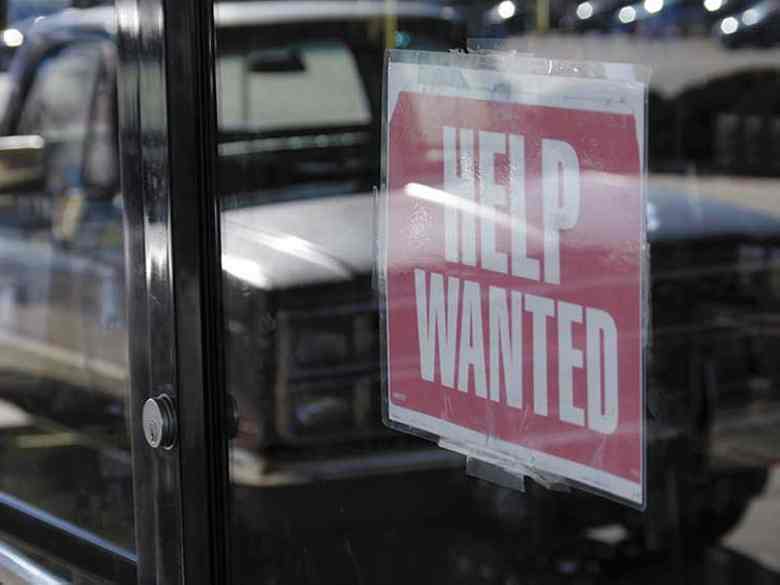The U.S. economic system added again 431,000 jobs in March because the unemployment charge slid to three.6% — simply above pre-pandemic lows. After the roles report confirmed an additional tightening of the labor market, the Dow Jones industrial common dipped into unfavorable territory, then rallied to shut barely increased. That is regardless of a key a part of the Treasury yield curve inverting, as buyers value in rising expectations for a collection of massive Federal Reserve charge hikes.
Personal-sector payrolls rose 426,000 in March, whereas authorities jobs rose 5,000.
Wall Avenue had anticipated the March jobs report to point out a much bigger achieve of 490,000 jobs, together with 458,000 within the non-public sector. Nonetheless, job positive aspects for January and February had been revised up by 95,000. The initially reported achieve of 678,000 jobs in February was revised to 750,000.
Economists anticipated the unemployment charge to ease to three.7% from 3.8%.
The common hourly wage rose 0.4% on the month, whereas rising 5.6% from a 12 months in the past, topping expectations of 5.5% annual wage progress.
Whereas wage positive aspects are very sturdy, they don’t seem to be maintaining with inflation. The annual CPI inflation charge hit 7.9% in February. The inflation charge most carefully watched by the Federal Reserve, the PCE value index, hit a 40-year excessive 6.4%, the Commerce Division mentioned Thursday. The decrease PCE inflation charge partly displays its broader base, which incorporates costs paid by authorities well being care applications.
Dow Jones, Treasury Yields React To Jobs Report
After the roles report, the Dow Jones rose 0.4% in Friday’s inventory market motion, after falling into unfavorable territory earlier within the session. The S&P 500 rose 0.4%. The Nasdaq composite edged up 0.3%, after a firmer morning rally faltered.
The inventory market rally is constructed on hope that the Federal Reserve can rein in inflation with out tipping the U.S. economic system right into a recession. But that sanguine outlook depends upon how a lot and how briskly the Fed has to tighten financial coverage. Friday’s jobs report bumped up the percentages that the Fed will hike its benchmark rate of interest a half-point on the subsequent assembly, Might 3-4.
The CME Group FedWatch web page now reveals 75% odds of a 50-basis-point hike, up from 70% yesterday. However the massive change is that Wall Avenue now expects half-point hikes on the June and July conferences additionally. Odds that the Fed’s key charge will rise not less than one other 1.5 proportion factors by the July assembly are actually at 61.5% vs. 43.5% the prior day and 0% a month in the past.
As of Thursday, the S&P 500 and Dow Jones had climbed to inside 5.5%-6% of all-time closing highs. The Nasdaq, after sinking into bear-market territory with a 20%+ drop, now stands 11.4% off its peak shut. The Nasdaq has underperformed the Dow and S&P, as progress inventory valuations have been pinched extra by rising rates of interest.
The ten-year Treasury yield rose 6 foundation factors to 2.38% after Friday’s jobs report. Nonetheless, the two-year Treasury yield shot as much as 2.45%, overtaking the 10-year and inverting a key a part of the yield curve.
A yield-curve inversion, with short-term charges rising above long-term charges, typically factors to an financial slowdown and potential recession. However buyers should not get spooked by the flat yield curve, Deutsche Financial institution strategist Maximilian Uleer wrote this week. For one factor, the 10-year Treasury yield has risen, not fallen, which suggests a comparatively agency progress outlook.
He notes that 5 of six yield-curve inversions preceded a recession, although that features the 2020 recession triggered by Covid. In these 5 situations, it has taken 7 to 34 months from inversion to recession’s onset. He calls yield-curve inversions a “poor indicator of timing.”
That additionally applies to the S&P 500. In all six instances, the S&P 500 continued to rally after the inversion, peaking 3 to 25 months later, Uleer writes. The common S&P 500 achieve: 19%.
Remember to learn IBD’s The Massive Image column after every buying and selling day to get the most recent on the prevailing inventory market pattern and what it means in your buying and selling choices.
Jobs Report Particulars
The leisure and hospitality sector added 112,000 jobs. Manufacturing unit employment grew by 38,000.
Building jobs rose by 19,000. Well being care and social help payrolls rose 33,000. Retailers added 49,000 jobs.
Unemployment Charge
The family survey, which is used to derive the unemployment charge, confirmed the ranks of the employed rising by a powerful 736,000. The variety of individuals collaborating within the labor drive, that means they’re working or actively on the lookout for a job, rose 418,000, not sufficient to maintain the unemployment charge from sliding.
The share of the working age inhabitants (age 16 and up) collaborating within the labor drive rose to 62.4%, matching expectations.
In line with the month-to-month survey of households, 5.95 million Individuals are unemployed. That is solely up modestly from 5.8 million unemployed in February 2020.
Fed projections present the unemployment charge easing to three.5% this 12 months and holding there, then rising barely to three.6% in 2024. That may, certainly, represent a delicate touchdown. Nonetheless, each drop within the unemployment charge from present ranges will elevate the percentages that the labor market will overshoot Fed projections.
That is what Jefferies chief U.S. monetary economist Aneta Markowska expects. “With (the) unemployment charge prone to fall to three% by the top of the 12 months, we count on wage progress to speed up to about 6%,” she wrote on March 25.
That may elevate the danger of a wage-price spiral, as employees use the tight job market to leverage pay will increase that are not eroded by inflation, however companies go alongside these further prices with extra value will increase.
To attain the delicate financial touchdown that the Fed desires, much more nonworkers must come off the sidelines, serving to take some steam out of wage progress.


